 By Bob Currie, Recreational Boating Safety Specialist
By Bob Currie, Recreational Boating Safety Specialist
U. S. Coast Guard Auxiliary Station Galveston Flotilla
Last week we talked about how you could become a well-trained passenger. All boat owners can use some help now and then from their passengers, especially when docking or casting off from the dock. This column will give you some line handling knowledge.
The Station Galveston Flotilla of the US Coast Guard Auxiliary operates out of the USCG Station Galveston base on Galveston Island. They aid the Coast Guard by providing maritime observation patrols in Galveston Bay; by providing recreational boating vessel safety checks; and by working alongside Coast Guard members in maritime accident investigation, small boat training, providing a safety zone, Aids to Navigation verification, in the galley, on the Coast Guard Drone Team and watch standing.
Classification by Line Type
Nautical lines and ropes may be classified by design and by material type. The two basic categories of line type are twisted rope and braided rope. The table below lists some characteristics of each line type.
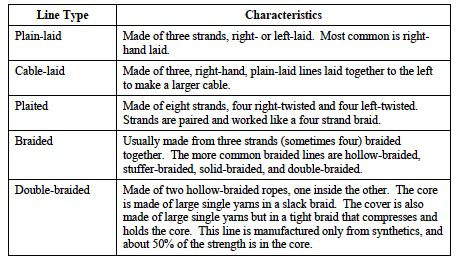
Classification by Line Material
The two basic categories of line materials are natural fibers and synthetic fibers. Of the different types of natural fibers, about the only natural fiber line still being used is cotton. There are several types of synthetic fiber lines, and each has its best use. The synthetic line materials most often used include nylon, dacron (polyester), and polypropylene. Steel wire also plays an important part on sailboats. One of the biggest disadvantages of synthetic line is slippage- synthetic lines slip more easily than natural fiber lines, so care must be used when tying lines by leaving a longer tail than you would use on a cotton line.
Cotton
Cotton line is often used whenever strength and stretchability are not that important. Cotton’s advantage is that it is UV light resistant. However, it does not recover from being stretched, and has a lower breaking strength than synthetic materials. It is not recommended for use in load-bearing purposes. It works well for tying off fenders.
Polyester (Dacron)
Polyester line is the most popular type of rope used to dock a vessel. It is very elastic and is resistant to UV rays and to rotting. It easily sinks in the water and is affordable.
Polypropylene
Polypropylene is more elastic than polyester and floats on water. Its best use is in heaving lines. Its downside is that it is very susceptible to degradation by UV light.
Nylon
Nylon is the most elastic of the thee synthetic lines mentioned, and as such is able to absorb a lot of shock load. It is good as a towing line, but tends to fray over time due to exposure to the sun. Nylon line can be dangerous when it snaps due to being overloaded, so when it is used as a tow line crewmembers must not place themselves in position for a snapped line to strike them.
Line Inspection
Lines should be periodically inspected for the following:
1. Signs of aging (discoloration, brittleness)
2. Fraying
3. Kinks
4. Overloading (loss of stretchiness)
5. Foreign material (salt buildup, mold, sand, dirt, paint chips)
If any lines show signs of degradation they should be replaced and not used.
Line Maintenance
Lines can degrade with prolonged exposure to salt water and UV light. As the water dries out it leaves sharp grains of salt which can accelerate line fraying and reduce line strength quickly unless the line is well-rinsed with fresh water and dried before it is stored. Keeping your lines clean and drying them before storing them will prolong their life. 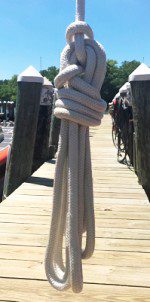 Try to tie knots in different places so as to not wear out the line. Loosen taut lines when they become wet as lines shrink when wet. This will help prevent line overloading.
Try to tie knots in different places so as to not wear out the line. Loosen taut lines when they become wet as lines shrink when wet. This will help prevent line overloading.
Stowing Lines
Lines should be stowed to prevent or lessen exposure to harmful chemicals, salt water, and UV rays from the sun. Synthetic line should not be coiled in the same direction, as doing this tends to tighten the line twist. Instead, it can be coiled in figure eights to avoid kinks when paying out (see picture).
To Be or Knot to Be
Good knots are easy to tie, easy to untie, and hold well. A knot is used to tie a line back on itself, a bend is used to tie one line to another line, and a hitch is used to tie a line to a ring, a rail, or a spar (mast or pole). The knots below are the most commonly used in boat operations.
Bowline
The bowline is a versatile knot and can be used any time a temporary eye is needed in the end of a line. All Boy Scouts know this knot. It is the knot used to make a loop to haul you back up the cliff. Although it is most often used on boat lines, I use a bowline to tie a hook on my fishing line since I can tie the knot without looking. The line will break before the knot will come undone.
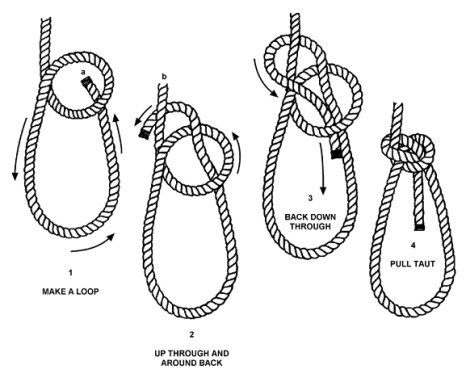
Two Half Hitches
Two half hitches are used to secure a line to a pole or spar. They are a good knot to secure a line at an angle where it might slide vertically or horizontally.
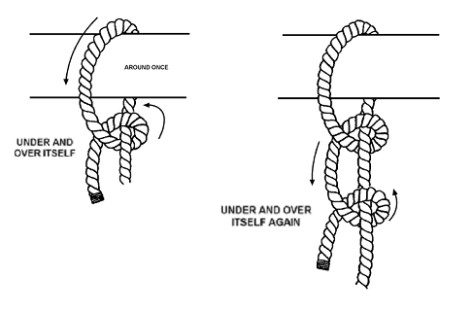
Clove Hitch
A clove hitch is the best knot for securing a line to a ring or spar, or for securing a heaving line to a tow line. Correctly tied, it will not jam or loosen. However, if it is not tied tight enough it will work itself out. Reinforcing it with a half hitch will prevent this from happening.
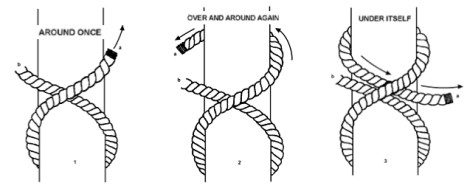
Sheet Bend
The sheet bend is used for tying one line to another, and works especially well when the lines are not the same size. (A sheet is a line tied to a sail.) The sheet bend is also known as a Becket bend. No, not the soccer player. A sheet bend can be taken apart even after it has been under heavy load, unlike the reef knot (also known as a square knot), which can jam and be nearly impossible to untie.
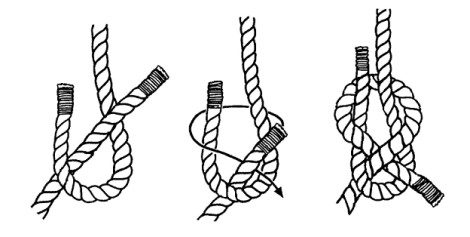
Reef Knot (Square Knot)
Called a square knot by Boy Scouts, the reef knot is one of the most commonly used knots to join two lines of equal size and material. If the knot is placed under heavy load it may jam, however, and be very difficult to untie.
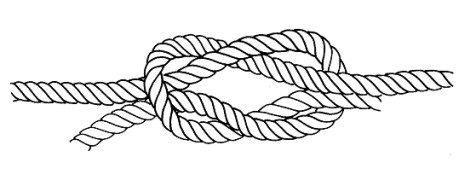
Securing a Dock Line to a Cleat Using the Eye
The standard dock line is usually 25 feet long and has an eye in one end. The eye is used to secure the line to a cleat. Although the pictures show securing the dock line to a dock cleat, I find it more useful to tie the dock line to a boat cleat before approaching the dock, and then you need only to secure the line to a cleat on the dock or use the dock line to make a turn around a dock pole and secure the line back to the boat cleat. The latter method makes it much easier to cast off from the dock.
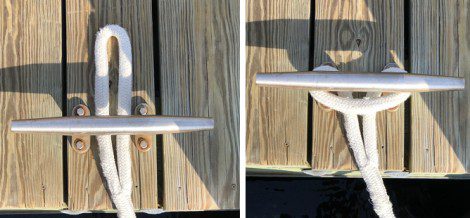
Securing a Line to a Cleat Using the Free End
This is the method used to secure a line to a dock cleat when mooring. That means you plan to be there a while. Not that a full turn is made around the bottom of the cleat prior to making three figure eights on the cleat. It is not necessary to make a final locking figure eight when a full round turn is first made.
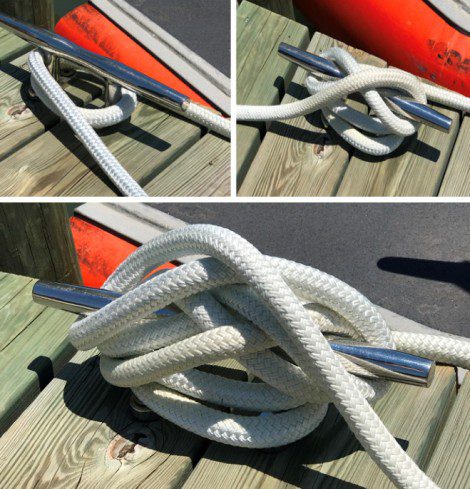
Summary
Line handling knowledge and experience can be very helpful to your captain when docking the boat or casting off. There are some smart phone apps out there that demonstrate all sorts of nautical knots. One way to practice knot tying is to have a couple of 2-foot sections of line that you can use for practice while watching TV. When you can tie the basic knots in such a setting with great proficiency, you are ready to try it on a rocking boat.
For more information on boating safety, please visit the Official Website of the U.S. Coast Guard’s Boating Safety Division at www.uscgboating.org. Questions about the US Coast Guard Auxiliary or our free Vessel Safety Check program may be directed to me at [email protected]. SAFE BOATING!
[Sept-21-2021]

 Posted in
Posted in 

























I’m saving these diagrams!